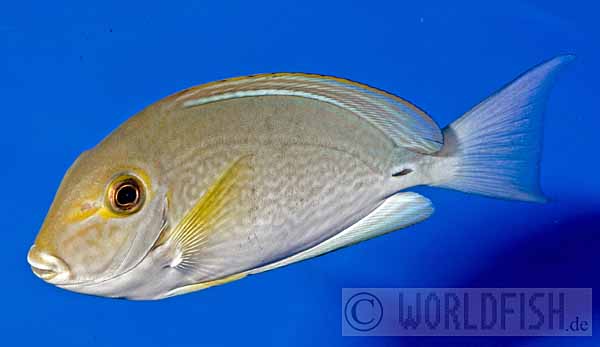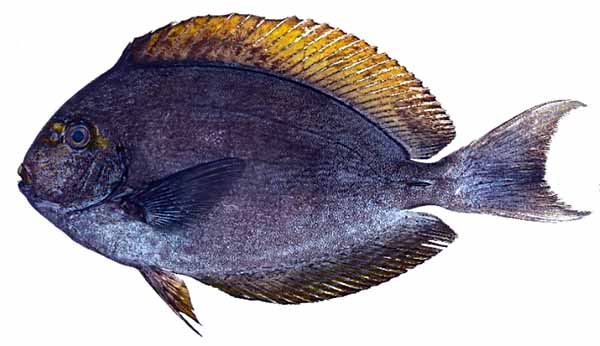Acanthurus mata: Unterschied zwischen den Versionen
Es (Diskussion | Beiträge) |
Es (Diskussion | Beiträge) |
||
| Zeile 29: | Zeile 29: | ||
== Etymologie == | == Etymologie == | ||
| − | . | + | Lokaler Name für diesen Fisch an der Coromandel-Küste von Indien, wie von {{aut|Russell}} (1803) berichtet. (Übersetzt aus: [https://etyfish.org/acanthuriformes2/ The ETYFish Project]) |
== Verbreitung == | == Verbreitung == | ||
| Zeile 65: | Zeile 65: | ||
==Literatur== | ==Literatur== | ||
[[Datei:Acanthurus mata.jpg|600px|thumb|right|''Acanthurus mata'' -- (C) {{aut|J.T. Williams}} (2017) in: ''Journal of the Ocean Science Foundation'', '''25''': 33–46.]] | [[Datei:Acanthurus mata.jpg|600px|thumb|right|''Acanthurus mata'' -- (C) {{aut|J.T. Williams}} (2017) in: ''Journal of the Ocean Science Foundation'', '''25''': 33–46.]] | ||
| − | {{Cuvier, 1829}}[:224, <span style="color: red">'''!!'''</span>, als ''Chaetodon | + | {{Russell, 1803}}[: 82, als Mata] |
| + | {{Cuvier, 1829}}[:224, <span style="color: red">'''!!'''</span>, als ''[[Chaetodon meta]]''] | ||
{{Günther, 1861}}[:335, <span style="color: red">'''!!'''</span>, als ''[[Acanthurus bleekeri]]''] | {{Günther, 1861}}[:335, <span style="color: red">'''!!'''</span>, als ''[[Acanthurus bleekeri]]''] | ||
{{Day, 1876}}[:204, Pl. 48 (fig. 3), <span style="color: red">'''!!''' </span>, als ''[[Acanthurus aurolineatus]]''] | {{Day, 1876}}[:204, Pl. 48 (fig. 3), <span style="color: red">'''!!''' </span>, als ''[[Acanthurus aurolineatus]]''] | ||
| Zeile 71: | Zeile 72: | ||
{{Weber, 1913}}[:317, <span style="color: red">'''!!'''</span>, als ''[[Acanthurus guentheri]]''] | {{Weber, 1913}}[:317, <span style="color: red">'''!!'''</span>, als ''[[Acanthurus guentheri]]''] | ||
{{Ahl, 1923}}[:37, <span style="color: red">'''!!'''</span>, als ''[[Hepatus weberi]]''] | {{Ahl, 1923}}[:37, <span style="color: red">'''!!'''</span>, als ''[[Hepatus weberi]]''] | ||
| + | {{de Beaufort & Chapman, 1951}}[:162, als ] | ||
| + | {{Randall, 1956}}[:218, als ''[[Acanthurus mata]]''] | ||
{{GRA77}}[: 19, als ''[[Acanthurus bleekeri]]'' (Farbfoto, Verbreitung)] | {{GRA77}}[: 19, als ''[[Acanthurus bleekeri]]'' (Farbfoto, Verbreitung)] | ||
| − | {{MA1a}}[: 711 (Farbfoto)] | + | {{Randall, 1988}}[:56] |
| + | {{MA1a}}[<!--1992-->: 711 (Farbfoto)] | ||
{{KUI06}}[: 670, Farbfoto] | {{KUI06}}[: 670, Farbfoto] | ||
{{Carpenter et al., 2017}}[: 42, (Farbtafel, Vergl. m. ähnlichen Arten)] | {{Carpenter et al., 2017}}[: 42, (Farbtafel, Vergl. m. ähnlichen Arten)] | ||
Aktuelle Version vom 8. Oktober 2021, 15:24 Uhr
(Cuvier, 1829)
|
Familie: Acanthuridae SynonymeChaetodon mata Cuvier, 1829 Lokale Bezeichnung |
 Acanthurus cf. mata (semiadult) -- (C) Erwin Schraml |
Typen
Keine Typusexemplare bekannt
Typusfundort: Keine Lokalität angegeben (Coromandel Küste, Indien, Ostindischer Ozean).
Etymologie
Lokaler Name für diesen Fisch an der Coromandel-Küste von Indien, wie von Russell (1803) berichtet. (Übersetzt aus: The ETYFish Project)
Verbreitung
Rotes Meer, Indo-West-Pazifik: Ostafrika, Südafrika, Madagaskar und westliche Maskarenen östlich bis Tuamotu-Archipel und Marquesas-Inseln, nördlich bis Süd-Japan und den Ogasawara-Inseln, südlich bis Queensland (Australien) und Neukaledonien sowie bis zu den Lord Howe Inseln.
IUCN Status
|
LC Least Concern (nicht gefährdet) Mögliche Gefahren für diese Art: Diese Art wird gezielt in Gebieten gefangen, in denen illegale Fangpraktiken vorkommen. |
EX Extinct (ausgestorben) EW Extinct in the Wild (in der Natur ausgestorben) CR Critically Endangered (vom Aussterben bedroht) EN Endangered (stark gefährdet) VU Vulnerable (gefährdet) NT Near Threatened (potenziell gefährdet) LC Least Concern (nicht gefährdet) RE Regionally Extinct (regional oder national ausgestorben) |
Literatur
- Russell, P. 1803. Descriptions and figures of two hundred fishes: collected at Vizagapatam on the coast of Coromandel. London, in 2 vols. v. 1-2: i-vii + 78 pp. + 85 pp., 197 pls. Zitatseite [: 82, als Mata]
- Cuvier, G. 1829. Le Règne Animal, distribué d'après son organisation, pour servir de base à l'histoire naturelle des animaux et d'introduction à l'anatomie comparée. Edition 2. 2: i-xv + 1-406. BHL Zitatseite [:224, !!, als Chaetodon meta]
- Günther, A. 1861. Catalogue of the fishes in the British Museum. Catalogue of the acanthopterygian fishes in the collection of the British Museum. Gobiidae, Discoboli, Pediculati, Blenniidae, Labyrinthici, Mugilidae, Notacanthi. London 3: i–xxv + 1–586 + i–x. (BHL) Zitatseite [:335, !!, als Acanthurus bleekeri]
- Day, F. 1876. The fishes of India; being a natural history of the fishes known to Inhabit the seas and fresh waters of India, Burma, and Ceylon. Part 2: 169-368, Pls. 41-78. Zitatseite [:204, Pl. 48 (fig. 3), !! , als Acanthurus aurolineatus]
- Fowler, H.W. 1904. A collection of fishes from Sumatra. Journal of the Academy of Natural Sciences, Philadelphia. (Second series) 12 (4): 495-560, Pls. 7-28. Zitatseite [:544, Pl. 22 (obere Abb.), !!, als Harpurus gnophodes]
- Weber, M. 1913. Die Fische der Siboga-Expedition. E.J. Brill, Leiden: i-xii + 1-710, Pls. 1-12. Zitatseite [:317, !!, als Acanthurus guentheri]
- Ahl, E. 1923. Ueber eine neue Art der Gattung Hepatus. In: Ichthyologische Mitteilungen, III. Mitteilungen aus dem Zoologischen Museum in Berlin, 11 (1): 36-37. Zitatseite [:37, !!, als Hepatus weberi]
- de Beaufort, L.F. & Chapman, W.M. 1951. IX. Percomorphi (concluded), Blennoidea. In:
- Weber, M. & de Beaufort, L.F. (eds.) 1951. The fishes of the Indo-Australian Archipelago. IX. Percomorphi (concluded), Blennoidea. E. J. Brill, Leiden. 9: i-xi + 1-484. Zitatseite Zitatseite [:162, als ]
- Randall, J.E. 1956. A revision of the surgeon fish genus Acanthurus. Pacific Science, 10 (2): 159-235, Pls. 1-3. (PDF) Zitatseite [:218, als Acanthurus mata]
- de Graaf, F. 1977. Tropische Zierfische im Meerwasseraquarium. Verlag Neumann-Neudamm, Melsungen. 1-468. Zitatseite [: 19, als Acanthurus bleekeri (Farbfoto, Verbreitung)]
- Randall, J.E. 1988. Five new wrasses of the genera Cirrhilabrus and Paracheilinus (Perciformes: Labridae) from the Marshall Islands. Micronesica, 21: 199-226, Pls. 1-3. Zitatseite [:56]
- Baensch, H.A. & Debelius, H. 1992. Meerwasser-Atlas Band 1. Mergus-Verlag, Melle. 1. Auflage. Zitatseite [: 711 (Farbfoto)]
- Kuiter, R. & Debelius, H. 2006. Atlas der Meeresfische. Kosmos Verlag. Zitatseite [: 670, Farbfoto]
- Carpenter, K.E., Williams, J.T. & Santos, M.D. 2017. Acanthurus albimento, a new species of surgeonfish (Acanthuriformes: Acanthuridae) from northeastern Luzon, Philippines, with comments on zoogeography. Journal of the Ocean Science Foundation, 25: 33–46. (doi) Zitatseite [: 42, (Farbtafel, Vergl. m. ähnlichen Arten)]

